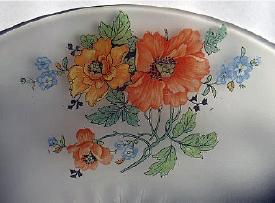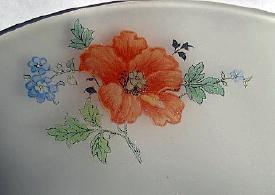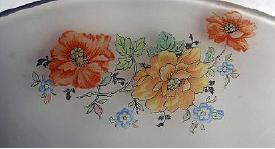DECALWARE
By Vicki Wollenhaupt
Issue No. 406 - April 2007
If you enjoy a good mystery Decalware should appeal to you. A
piece of decalware is like the subtle clue sitting in plain view. The
 shape is obviously Cambridge but it is presented with a treatment
and decoration that is unobtrusive.
shape is obviously Cambridge but it is presented with a treatment
and decoration that is unobtrusive.
Decalware is a descriptive name that has been given to this decoration by collectors. To date company information does not exist. This is believed to be a Cambridge Company decoration. The pieces are satin finished over the entire surface. There are two types of satin finish, a very smooth finish and a more sandy type. The smooth "satin" finish was achieved by treating the piece with a hydrofluoric/sulfuric acid bath. The "sandy" type was achieved by sand blasting. Why were two different methods used? We do not know for sure. Logical speculation would be that sand blasting won out over the acid method. It would be cost effective plus less hazardous.
A set of floral decals are placed on each piece. The size of the
piece dictates how many decals you may find. A flat piece has
three or four segments of the decal while a small piece may have
only one flower. One disadvantage to having a decal is that heavy
use tends to show a good amount of wear to the decal. A full
segment of the floral decal is just about 4 inches wide and 3 inches
long. In describing the floral decal it helps to have a little gardening
experience. The three largest flowers appear to be poppies. The
 largest poppy is orange and in full open bloom. The poppy bloom
next to that is lighter in color and in mid bloom. The third poppy
is smaller and placed below and to the left of the poppy in mid
bloom. There are sprays of tiny blue flowers at the sides of the
poppies. These have the appearance of forget-me-nots. The green
leaves have the shape of the leaves found on the stems of poppies.
There are very tiny leaves that are floating and appear to be very
dark gray or black. These tiny leaves provide contrast. Even if a
piece is very small and only has enough surface for a single flower
it will be one of the poppies. A good source for reviewing the
oriental poppy would be most garden websites or a seed catalogue.
largest poppy is orange and in full open bloom. The poppy bloom
next to that is lighter in color and in mid bloom. The third poppy
is smaller and placed below and to the left of the poppy in mid
bloom. There are sprays of tiny blue flowers at the sides of the
poppies. These have the appearance of forget-me-nots. The green
leaves have the shape of the leaves found on the stems of poppies.
There are very tiny leaves that are floating and appear to be very
dark gray or black. These tiny leaves provide contrast. Even if a
piece is very small and only has enough surface for a single flower
it will be one of the poppies. A good source for reviewing the
oriental poppy would be most garden websites or a seed catalogue.
To date a few colored pieces have surfaced. This appears not to have been popular, probably because it is much more difficult to see the decal on a colored satin finished piece. The colored pieces were in light transparent pink, green and amber. The pieces have been bowls and a handled sandwich tray.
Decalware dates from probably 1926 thru 1930 or 1931. The vast majority of the known pieces can be found in the 1927 – 1929 catalogue. Stemware has not surfaced but several varieties of flat tumblers have been found.
The following are some of the more interesting pieces. All of these shapes can be found in the Smith 1927-29 catalogue reprint.

- #427 – 6 ½" relish #623 – 5 pc highball
- #389 – 13" 2 pc relish #387 – 2 ½" ashtray
- #95 – 1 lb candy jar #507 – 2 pc temple jar
- #105 – 62 oz pitcher #814 – pitcher (cream or syrup)
- #39 – ice tub
On a personal note, a tip of the hat goes to Ed Ruby. This gentleman was one of the founding members of the Club and one of the original Board of Directors. Mr. Ruby was collecting decalware 35 years ago and my interest was sparked by his collection. Please share any of your interesting decalware finds with your fellow collectors.
Please note that all of the photos of the decal have been photographed from the underside of the object. This allows the viewer to see more detail of the actual "decal".
